Regionalization of Climate Change Simulations for the Assessment of Impacts on Precipitation, Flow Rate and Electricity Generation in the Xingu River Basin in the Brazilian Amazon
Abstract
1. Introduction
2. Materials and Methods
2.1. Region of Study
2.2. Future Emission Scenarios and GCMs
2.3. Rainfall–Runoff Model
2.4. Hydropower Generation Estimation
2.5. Skill Assessment
3. Results
3.1. Statistical Downscaling Model Evaluations
3.2. Climate Scenarios Applied to Precipitation
3.3. Projections of Future Flow Rates
3.4. Electricity Generation in Belo Monte
4. Discussion
5. Conclusions
Author Contributions
Funding
Data Availability Statement
Acknowledgments
Conflicts of Interest
References
- EPE—Empresa de Pesquisa Energética. Anuário Estatístico de Energia Elétrica. 2020. Available online: http://www.epe.gov.br (accessed on 5 March 2021).
- De Souza Dias, V.; Pereira da Luz, M.; Medero, G.M.; Tarley Ferreira Nascimento, D. An Overview of Hydropower Reservoirs in Brazil: Current Situation, Future Perspectives and Impacts of Climate Change. Water 2018, 10, 592. [Google Scholar] [CrossRef]
- De Menezes, J.B.; Bandeira, O.M.; Leite, D.T. A construção do complexo hidrelétrico de Belo Monte: Quarta maior do mundo em capacidade instalada. Rev. Bras. Eng. Barragens 2017, 4, 5–21. [Google Scholar]
- Norte Energia. UHE Belo Monte, a Maior Usina Hidrelétrica 100% Brasileira. Brasília. Available online: https://www.norteenergiasa.com.br/pt-br/uhe-belo-monte/a-usina (accessed on 20 March 2021).
- Mendes, C.A.B.; Beluco, A.; Canales, F.C. Some important uncertainties related to climate change in projections for the Brazilian hydropower expansion in the Amazon. Energy 2017, 141, 123–138. [Google Scholar] [CrossRef]
- De Queiroz, A.R.; Faria, V.A.D.; Lima, L.M.M.; Lima, J.W. Hydropower revenues under the threat of climate change in Brazil. Renew. Energy 2019, 133, 873–882. [Google Scholar] [CrossRef]
- Chou, S.C.; Lyra, A.; Mourão, C.; Dereczynski, C.; Pilotto, I.; Gomes, J.; Bustamante, J.; Tavares, P.; Silva, A.; Rodrigues, D.; et al. Assessment of Climate Change over South America under RCP 4.5 and 8.5 Downscaling Scenarios. Am. J. Clim. Chang. 2014, 3, 512–525. [Google Scholar] [CrossRef]
- Martins, G.; Von Randow, C.; Sampaio, G.; Dolman, A.J. Precipitation in the Amazon and its relationship with moisture transport and tropical Pacific and Atlantic SST from the CMIP5 simulation. Hydrol. Earth Syst. Sci. 2015, 12, 671–704. [Google Scholar]
- Woldemeskel, F.M.; Sharma, A.; Sivakumar, B.; Mehrotra, R. An error estimation method for precipitation and temperature projections for future climates. J. Geophys. Res. Atmos. 2012, 117, D22. [Google Scholar] [CrossRef]
- Addor, N.; Seibert, J. Bias correction for hydrological impact studies—Beyond the daily perspective. Hydrol. Process. 2014, 28, 4823–4828. [Google Scholar] [CrossRef]
- Hakala, K.; Addor, N.; Teutschbein, C.; Vis, M.; Dakhlaoui, H.; Seibert, J. Hydrological Modeling of Climate Change Impacts. In Encyclopedia of Water: Science, Technology, and Society; Wiley: Hoboken, NJ, USA, 2019; pp. 1–20. [Google Scholar] [CrossRef]
- Meresa, H.K.; Romanowicz, R.J. The critical role of uncertainty in projections of hydrological extremes. Hydrol. Earth Syst. Sci. 2017, 21, 4245–4258. [Google Scholar] [CrossRef]
- Kundzewicz, Z.W.; Krysanova, V.; Benestad, R.E.; Hov, O.; Piniewski, M.; Otto, I.M. Uncertainty in climate change impacts on water resources. Environ. Sci. Policy 2018, 79, 1–8. [Google Scholar] [CrossRef]
- Hattermann, F.F.; Vetter, T.; Breuer, L.; Su, B.; Daggupati, P.; Donnelly, C.; Fekete, B.; Flörke, F.; Gosling, S.N.; Hoffmann, P.; et al. Sources of uncertainty in hydrological climate impact assessment: A cross-scale study. Environ. Res. Lett. 2018, 13, 015006. [Google Scholar] [CrossRef]
- Dos Santos, D.J.; Pedra, G.U.; Da Silva, M.G.B.; Junior, C.A.G.; Alves, L.M.; Sampaio, G.; Marengo, J.A. Future rainfall and temperature changes in Brazil under global warming levels of 1.5 °C, 2 °C and 4 °C. Sustain. Debate 2020, 11, 57–73. [Google Scholar] [CrossRef]
- De Moura, C.N.; Seibertb, J.; Mine, M.R.M. Uncertainties in Projected Rainfall over Brazil: The Role of Climate Model, Bias Correction and Emission Scenario. California Digital Library. 2020. Available online: https://www.sciencegate.app/document/10.31223/osf.io/2p9wg (accessed on 20 July 2022).
- Yin, L.; Fu, R.; Shevliakova, E.; Dickson, R.E. How well can CMIP5 simulate precipitation and its controlling processes over tropical South America? Clim. Dyn. 2013, 41, 3127–3143. [Google Scholar] [CrossRef]
- Guimberteau, M.; Ronchail, J.; Espinoza, J.C.; Lengaigne, M.; Sultan, B.; Polcher, J.; Drapeau, G.; Guyot, J.-L.; Ducharne, A.; Ciais, P. Future changes in precipitation and impacts on extreme streamflow over Amazonian sub-basins. Environ. Res. Lett. 2013, 8, 014035. [Google Scholar] [CrossRef]
- De Oliveira, B.F.A.; Bottino, M.J.; Nobre, P.; Nobre, C. Deforestation and climate change are projected to increase heat stress risk in the Brazilian Amazon. Commun. Earth Environ. 2021, 2, 207. [Google Scholar] [CrossRef]
- Joetzjer, E.; Douville, H.; Delire, C.; Ciais, P. Present-day and future Amazonian precipitation in global climate models: CMIP5 versus CMIP3. Clim. Dyn. 2013, 41, 2921–2936. [Google Scholar] [CrossRef]
- Silva, J.P.; Pereira, D.I.; Aguiar, A.M.; Rodrigues, C. Geodiversity assessment of the Xingu drainage basin. J. Maps 2013, 9, 254–262. [Google Scholar] [CrossRef]
- Lucas, E.W.M.; Sousa, F.A.S.; Silva, F.D.S.; Rocha-Júnior, R.L.; Pinto, D.D.C.; Da Silva, V.P.R. Trends in climate extreme assessed in the Xingu river basin—Brazilian Amazon. Weather Clim. Extrem. 2021, 31, 10036. [Google Scholar] [CrossRef]
- Schwartzman, S.; Vilas-Boas, A.; Ono, K.Y.; Fonseca, M.G.; Doblas, J.; Zimmerman, B.; Junqueira, P.; Jerozolimski, A.; Salazar, M.; Junqueira, R.P.; et al. The natural and social history of the indigenous lands and protected areas corridor of the Xingu River basin. Philos. Trans. 2013, 368, 20120164. [Google Scholar] [CrossRef]
- De Oliveira, G.; Chen, J.M.; Mataveli, G.A.V.; Chaves, M.E.D.; Rao, J.; Sternberg, M.; Dos Santos, T.V.; Dos Santos, C.A.C. Evapotranspiration and Precipitation over Pasture and Soybean Areas in the Xingu River Basin, an Expanding Amazonian Agricultural Frontier. Agronomy 2020, 10, 1112. [Google Scholar] [CrossRef]
- Reboita, M.S.; Gan, M.A.; Da Rocha, R.P.; Ambrizzi, T. Regimes de precipitação na América do Sul: Uma revisão bibliográfica. Rev. Bras. Meteorol. 2010, 25, 185–204. [Google Scholar] [CrossRef]
- Dos Santos, C.A.; Lima, A.M.M.; Franco, V.S.; Araújo, I.B.; Menezes, J.F.G.; Gomes, N.M.O. Distribuição espacial da precipitação na bacia hidrográfica do rio Xingu. Nucleus 2016, 13, 223–230. [Google Scholar] [CrossRef][Green Version]
- De Azambuja, A.M.S. Climatologia da Precipitação na Bacia Hidrográfica do Rio Xingu; CPRM—Serviço Geológico do Brasil: Rio de Janeiro, Brazil, 2018. [Google Scholar]
- ANA—Agencia Nacional de Aguas. Plano Estratégico de Recursos Hídricos dos Afluentes da Margem Direita do rio Amazonas: Diagnóstico; ANA—Agencia Nacional de Aguas: Brasilia, Brazil, 2013. [Google Scholar]
- IPCC—Intergovernamental Panel on Climate Change. AR5 Climate Change 2014: Mitigation of Climate Change; Working Group III Contribution to the Fifth Assessment Report of the Intergovernmental Panel on Climate Change; Cambridge University Press: Cambridge, UK, 2014. [Google Scholar]
- Moss, R.H.; Edmonds, J.A.; Hibbard, K.A.; Manning, M.R.; Rose, S.K.; Van Vuuren, D.P.; Carter, T.R.; Emori, S.; Kainuma, M.; Kram, T.; et al. The next generation of scenarios for climate change research and assessment. Nature 2010, 463, 747–756. [Google Scholar] [CrossRef]
- Van Vuuren, D.P.; Edmonds, J.; Kainuma, M.; Riahi, K.; Thomsom, A.; Hibbard, K.; Hurtt, G.C.; Kram, T.; Krey, V.; Lamarque, J.-L.; et al. The representative concentration pathways: An overview. Clim. Chang. 2011, 109, 5–31. [Google Scholar] [CrossRef]
- Taylor, K.E.; Stouffer, R.J.; Meehl, G.A. An overview of CMIP5 and the experiment design. Bull. Am. Meteorol. Soc. 2012, 93, 485–498. [Google Scholar] [CrossRef]
- Arora, V.K.; Boer, G.J.; Christian, J.R.; Curry, C.L.; Denman, K.L.; Zahariev, K.; Flato, G.M.; Scinocca, J.F.; Merryfield, W.J.; Lee, W.G. The effect of terrestrial photosynthesis down-regulation on the 20th century carbon budget simulated with the CCCma earth system model. J. Clim. 2009, 22, 6066–6088. [Google Scholar] [CrossRef]
- Christian, J.R.; Arora, V.K.; Boer, G.J.; Curry, C.L.; Zahariev, K.; Denman, K.L.; Flato, G.M.; Lee, W.G.; Merryfield, W.J.; Roulet, N.T.; et al. The global carbon cycle in the Canadian Earth system model CanESM1: Preindustrial control simulation. J. Geophys. Res. 2010, 115, G03014. [Google Scholar] [CrossRef]
- Salas-Mélia, D.; Chauvin, F.; Déqué, M.; Douville, H.; Gueremy, J.F.; Marquet, P.F.; Planton, S.; Royer, J.F.; Tyteca, S. Description and Validation of the CNRM-CM3 Global Coupled Model; CNRM Technical Report; Centre National de Recherches Meteorologiques: Toulouse, France, 2005; 103p. [Google Scholar]
- Voldoire, A.; Sanchez-Gomez, E.; Salas y Mélia, D.; Decharme, B.; Cassou, C.; Sénési, S.S.; Valcke, S.; Beau, I.; Alias, A.; Chevallier, M.; et al. The CNRM-CM5.1 global climate model: Description and basic evaluation. Clim. Dyn. 2011, 40, 2091–2121. [Google Scholar] [CrossRef]
- Giorgetta, M.; Jungclaus, J.; Reick, C.; Legutke, S.; Bader, J.; Böttinger, M.; Brovkin, V.; Crueger, T.; Esch, M.; Fieg, K.; et al. Climate and carbon cycle changes from 1850 to 2100 in MPI-ESM simulations for the coupled model intercomparison project phase 5. J. Adv. Model. Earth Syst. 2013, 5, 572–597. [Google Scholar] [CrossRef]
- Müller, W.; Jungclaus, J.; Mauritsen, T.; Baehr, J.; Bittner, M.; Budich, R.; Bunzel, F.; Esch, M.; Ghosh, R.; Haak, H.; et al. A higher-resolution version of the Max Planck Institute Earth System Model (MPI-ESM 1.2—HR). J. Adv. Model. Earth Syst. 2018, 10, 1383–1413. [Google Scholar] [CrossRef]
- Bentsen, M.; Bethke, I.; Debernard, J.B.; Iversen, T.; Kirkevag, A.; Seland, O.; Drange, H.; Roelandt, C.; Seierstad, I.A.; Hoose, C.; et al. The Norwegian Earth System Model, NorESM1-M—Part 1: Description and basic evaluation of the physical climate. Geosci. Model Dev. 2013, 6, 687–720. [Google Scholar] [CrossRef]
- Guo, C.; Bentsen, M.; Bethke, I.; Ilicak, M.; Tjiputra, J.; Toniazzo, T.; Schwinger, J.; Ottera, O.H. Description and evaluation of NorESM1-F: A fast version of the Norwegian Earth System Model (NorESM). Geosci. Model Dev. 2019, 12, 343–362. [Google Scholar] [CrossRef]
- Wilby, R.L.; Charles, S.P.; Zorita, E.; Timbal, B.; Whetton, P.; Mearns, L.O. Guidelines for Use of Climate Scenarios Developed from Statistical Downscaling Methods. 2004. Available online: http://ipcc-ddc.cru.uea.ac.uk/guidelines/dgm_no2_v1_09_2004.pdf (accessed on 20 July 2021).
- Silva, F.D.S.; Costa, R.L.; Da Rocha Júnior, R.L.; Gomes, H.B.; Azevedo, P.V.; Silva, V.P.R.; Monteiro, L.A. Cenários Climáticos e Produtividade do Algodão no Nordeste do Brasil. Parte II: Simulação Para 2020 a 2080. Rev. Bras. Meteorol. 2021, 35, 913–929. [Google Scholar] [CrossRef]
- Fowler, H.J.; Blenkinsop, S.; Tebaldi, C. Linking climate change modelling to impacts studies: Recent advances in downscaling techniques for hydrological modelling. Int. J. Climatol. 2007, 27, 1547–1578. [Google Scholar] [CrossRef]
- Dee, D.P.; Uppala, S.M.; Simmons, A.J.; Berrisford, P.; Poli, P.; Kobayashi, S.; Andrae, U.; Balmaseda, M.A.; Balsamo, G.; Bauer, P.; et al. The ERA-Interim reanalysis: Configuration and performance of the data assimilation system. Q. J. R. Meteorol. Soc. 2011, 137, 553–597. [Google Scholar] [CrossRef]
- Gutiérrez, J.M.; San-Martin, D.; Brands, S.; Manzanas, R.; Herrera, S. Reassessing statistical downscaling techniques for their robust application under climate change conditions. J. Clim. 2013, 26, 171–188. [Google Scholar] [CrossRef]
- Costa, R.L.; Gomes, H.B.; Silva, F.D.S.; Baptista, G.M.M.; Da Rocha Júnior, R.L.; Herdies, D.L.; Silva, V.P.R. Cenários de Mudanças Climáticas para a Região Nordeste do Brasil por meio da Técnica de Downscaling Estatístico. Rev. Bras. Meteorol. 2021, 35, 785–801. [Google Scholar] [CrossRef]
- Costa, R.L.; Baptista, G.M.M.; Gomes, H.B.; Silva, F.D.S.; Da Rocha Júnior, R.L.; Nedel, A.S. Analysis of future climate scenarios for northeastern Brazil and implications for human thermal comfort. An. Acad. Bras. Ciênc. 2021, 93, 1–23. [Google Scholar] [CrossRef]
- Ramírez, M.C.V.; Ferreira, N.J.; Velho, H.F.C. Linear and nonlinear statistical downscaling for rainfall forecasting over Southeastern Brazil. Weather Forecast. 2006, 21, 969–989. [Google Scholar] [CrossRef]
- Hertig, E.; Maraun, D.; Bartholy, J.; Pongracz, R.; Vrac, M.; Mares, I.; Gutiérrez, J.M.; Wibig, J.; Casanueva, A. Comparison of statistical downscaling methods with respect to extreme events over Europe: Validation results from the perfect predictor experiment of the COST Action VALUE. Int. J. Climatol. 2018, 39, 3846–3867. [Google Scholar] [CrossRef]
- Zorita, E.; Storch, H.V. The analog method as a simple Statistical Downscaling Technique: Comparison with more complicated methods. J. Clim. 1999, 12, 2474–2489. [Google Scholar] [CrossRef]
- Chen, J.; Brissette, F.P.; Chaumont, D.; Braun, M. Finding appropriate bias correction methods in downscaling precipitation for hydrologic impact studies over North America. Water Resour. Res. 2013, 49, 4187–4205. [Google Scholar] [CrossRef]
- Lenderink, G.; Buishand, A.; Deursen, W. Estimates of future discharges of the river Rhine using two scenario methodologies: Direct versus delta approach. Hydrol. Earth Syst. Sci. 2007, 11, 1145–1159. [Google Scholar] [CrossRef]
- Kendall, M.G. Rank Correlation Methods; Charles Griffin: London, UK, 1975; 120p. [Google Scholar]
- Hotelling, H. The relations of the newer multivariate statistical methods to factor analysis. Br. J. Math. Stat. Psychol. 1957, 10, 69–79. [Google Scholar] [CrossRef]
- Rencher, A.C. Methods of Multivariate Analysis, 2nd ed.; Brigham Young University: Provo, UT, USA; Wiley: Hoboken, NJ, USA, 2002; 737p. [Google Scholar]
- Izenman, A.J. Modern Multivariate Statistical Techniques; Springer: Berlin, Germany, 2008. [Google Scholar]
- Lucas, E.W.M.; Sousa, F.A.S.; Silva, F.D.S.; Da Rocha Júnior, R.L.; Ataíde, K.R.P. Previsões de vazões mensais na bacia hidrográfica do Xingu—Leste da Amazônia. Rev. Bras. Meteorol. 2020, 35, 1045–1056. [Google Scholar] [CrossRef]
- IRI—International Research Institute for Climate and Society. The Climate Predictability Tool. 2019. Available online: https://iri.columbia.edu/our-expertise/climate/tools/cpt/ (accessed on 15 August 2019).
- Lucio, P.S.; Silva, F.D.S.; Fortes, L.T.G.; Santos, L.A.R.; Ferreira, D.B.; Salvador, M.A.; Balbino, H.T.; Sarmanho, G.F.; dos Santos, L.S.F.C.; Lucas, E.W.M.; et al. Um modelo estocástico combinado de previsão sazonal para a precipitação no Brasil. Rev. Bras. Meteorol. 2010, 25, 70–87. [Google Scholar] [CrossRef]
- Kipkogei, O.; Mwanthi, A.M.; Mwesigwa, J.B.; Atheru, Z.K.K.; Wanzala, M.A.; Artan, G. Improved Seasonal Prediction of Rainfall over East Africa for Application in Agriculture: Statistical Downscaling of CFSv2 and GFDL-FLOR. J. Appl. Meteorol. Climatol. 2017, 56, 3229–3243. [Google Scholar] [CrossRef]
- Esquivel, A.; Llanos-Herrera, L.; Agudelo, D.; Prager, S.D.; Fernandes, K.; Rojas, A.; Valencia, J.J.; Ramirez-Villegas, J. Predictability of seasonal precipitation across major crop growing areas in Colombia. Clim. Serv. 2018, 12, 36–47. [Google Scholar] [CrossRef]
- Landman, W.A.; Barnston, A.G.; Vogel, C.; Savy, J. Use of El Niño–Southern Oscillation related seasonal precipitation predictability in developing regions for potential societal benefit. Int. J. Climatol. 2019, 39, 5327–5337. [Google Scholar] [CrossRef]
- Da Rocha Júnior, R.L.; Cavalcante Pinto, D.D.; dos Santos Silva, F.D.; Gomes, H.B.; Barros Gomes, H.; Costa, R.L.; Santos Pereira, M.P.; Peña, M.; dos Santos Coelho, C.A.; Herdies, D.L. An Empirical Seasonal Rainfall Forecasting Model for the Northeast Region of Brazil. Water 2021, 13, 1613. [Google Scholar] [CrossRef]
- Stickler, C.M.; Coe, M.T.; Costa, M.H.; Nepstad, D.C.; Mcgrath, D.G.; Dias, L.C.P.; Rodrigues, H.O.; Soares-Filho, B.S. Dependence of hydropower energy generation on forests in the Amazon Basin at local and regional scales. Proc. Natl. Acad. Sci. USA 2013, 4, 9601–9609. [Google Scholar] [CrossRef]
- EPE—Empresa de Pesquisa Energética. Estudos para Licitação da Expansão da Geração: Cálculo da Garantia Física da UHE Belo Monte (Nota Técnica EPE-DEE-RE-004/2010-R0). 2010. Available online: http://www.epe.gov.br (accessed on 5 March 2021).
- Taylor, R. Interpretation of the correlation coefficient: A basic review. Journal of Diagnostic Medical Sonography 1990, 6, 35–39. [Google Scholar] [CrossRef]
- Bozzini, P.L.; Mello Junior, A.V. Previsões de precipitação de modelos atmosféricos como subsídio à operação de sistemas de reservatório. Rev. Bras. Meteorol. 2020, 35, 99–109. [Google Scholar] [CrossRef]
- Wilks, D.S. Statistical Methods in the Atmospheric Sciences, 2nd ed.; Elsevier Academic Press Publications: Cambridge, MA, USA, 2006. [Google Scholar]
- Lyra, A.A.; Chou, S.C.; Sampaio, G.O. Sensitivity of the Amazon biome to high resolution climate change projections. Acta Amaz. 2016, 46, 175–188. [Google Scholar] [CrossRef]
- Kirschbaum, M.; Fischin, A. Climate change impacts on forests. In Climate Change 1995: Impacts, Adaptation and Mitigation of Climate Change: Scientific-Technical Analysis; Watson, R., Zinyowera, M.C., Moss, R.H., Eds.; Cambridge University Press: Cambridge, UK, 1996; pp. 95–129. [Google Scholar]
- Miles, L.; Grainger, A.; Phillips, O. The impact of global climate change on tropical biodiversity in Amazonia. Glob. Ecol. Biogeogr. 2004, 13, 553–565. [Google Scholar] [CrossRef]
- Nobre, C.; Marengo, J.A. Mudanças Climáticas em Rede: Um Olhar Interdisciplinary; Instituto Nacional de Ciência e Tecnologia para Mudanças Climáticas: Sao Jose dos Campos, Brazil, 2017; 608p. [Google Scholar]
- Coe, M.T.; Costa, M.H.; Soares-Filho, B.S. The influence of historical and potential future deforestation on the streamflow of the Amazon River—Land surface processes and atmospheric feedbacks. J. Hydrol. 2009, 369, 165–174. [Google Scholar] [CrossRef]
- Farinosi, F.; Arias, M.E.; Lee, E.; Longo, M.; Pereira, F.F.; Livino, A.; Moorcroft, P.R.; Briscoe, J. Future climate and land use change impacts on river flows in the Tapajós Basin in the Brazilian Amazon. Earth Future 2019, 7, 993–1017. [Google Scholar] [CrossRef]
- Heerspink, B.P.; Kendall, A.D.; Coe, M.T.; Hyndman, D.W. Trends in streamflow, evapotranspiration, and groundwater storage across the Amazon Basin linked to changing precipitation and land cover. J. Hydrol. Reg. Stud. 2020, 32, 10075. [Google Scholar] [CrossRef]
- Von Randow, R.C.S.; Rodriguez, D.A.; Tomasella, J.; Aguiar, A.P.D.; Kruijt, B.; Kabat, P. Response of the river discharge in the Tocantins River Basin, Brazil, to environmental changes and the associated effects on the energy potential. Reg. Environ. Chang. 2019, 19, 193–204. [Google Scholar] [CrossRef]
- Mohor, G.S.; Rodriguez, D.A.; Tomasella, J.; Siqueira Junior, J.L. Exploratory analyses for the assessment of climate change impacts on the energy production in an Amazon run-of-river hydropower plant. J. Hydrol. Reg. Stud. 2015, 4, 41–59. [Google Scholar] [CrossRef]
- Siqueira Júnior, J.L.; Tomasella, J.; Rodriguez, D.A. Impacts of future climatic and land cover changes on the hydrological regime of the Madeira River basin. Clim. Chang. 2015, 129, 117–129. [Google Scholar] [CrossRef]
- De Jong, P.; Tanajura, C.A.S.; Sánchez, A.S.; Dargaville, R.; Kiperstok, A.; Torres, E.A. Hydroelectric production from Brazil’s São Francisco River could cease due to climate change and inter-annual variability. Sci. Total Environ. 2018, 634, 1540–1553. [Google Scholar] [CrossRef] [PubMed]
- Da Silva, M.V.M.; Silveira, C.S.; Da Costa, J.M.F.; Martins, E.S.P.R.; Vasconcelos Júnior, F.C. Projection of Climate Change and Consumptive Demands Projections Impacts on Hydropower Generation in the São Francisco River Basin, Brazil. Water 2021, 13, 332. [Google Scholar] [CrossRef]
- Mourão, C.; Chou, S.C.; Marengo, J. Downscaling Climate Projections over La Plata Basin. Atmos. Clim. Sci. 2016, 6, 62493. [Google Scholar] [CrossRef][Green Version]
- Figueroa, S.N.; Bonatti, J.P.; Kubota, P.Y.; Grell, G.A.; Morrison, H.; Barros, S.R.M.; Fernandez, J.P.R.; Ramirez, E.; Siqueira, L.; Luzia, G.; et al. The Brazilian Global Atmospheric Model (BAM): Performance for Tropical Rainfall Forecasting and Sensitivity to Convective Scheme and Horizontal Resolution. Weather Forecast. 2016, 31, 1547–1572. [Google Scholar] [CrossRef]
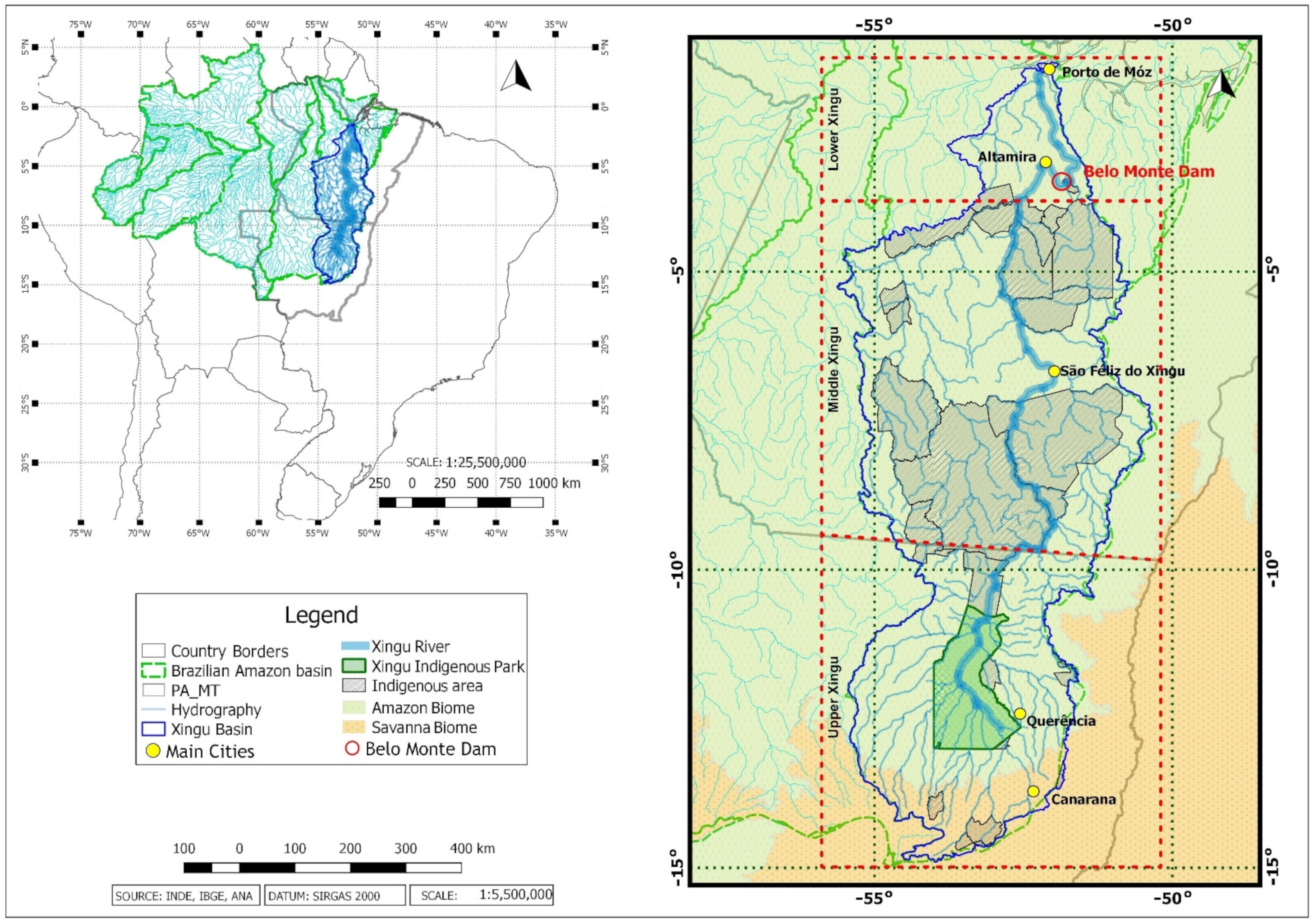
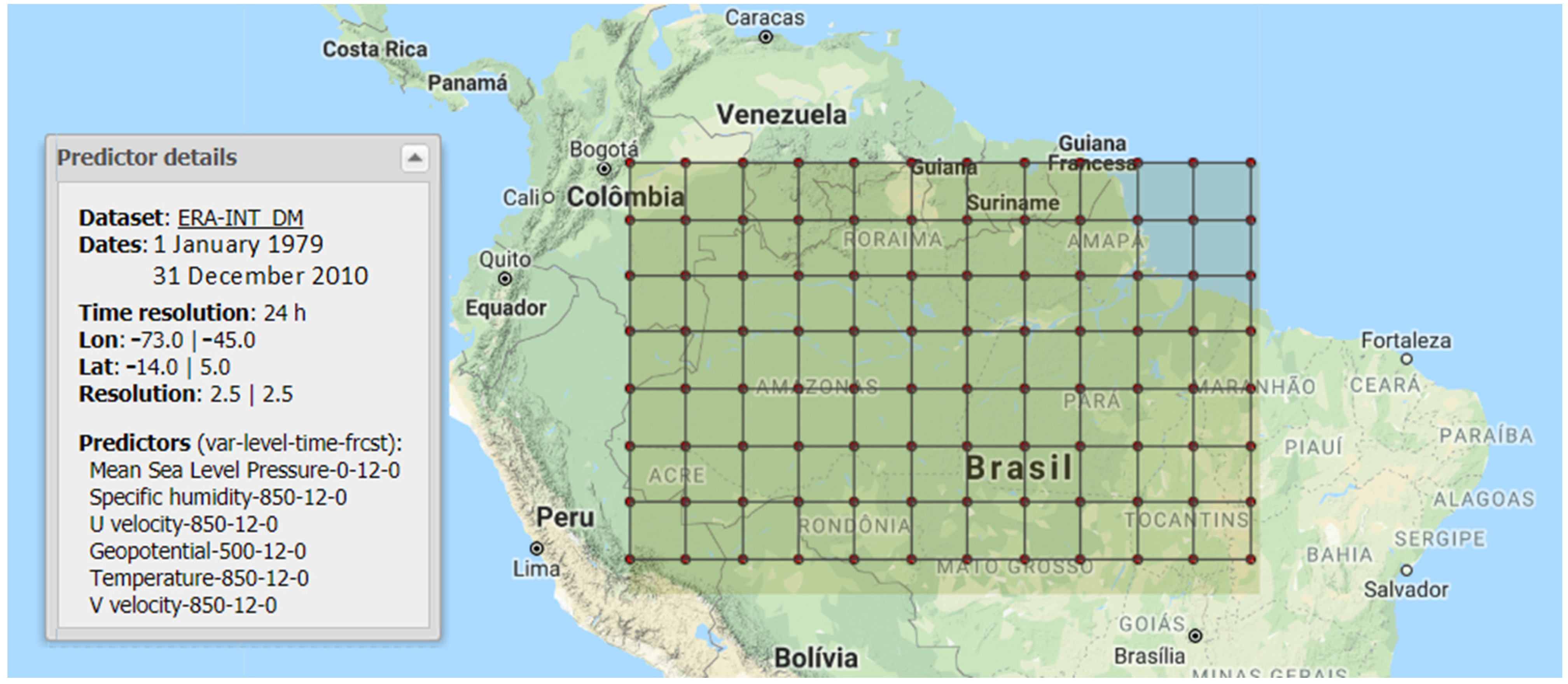

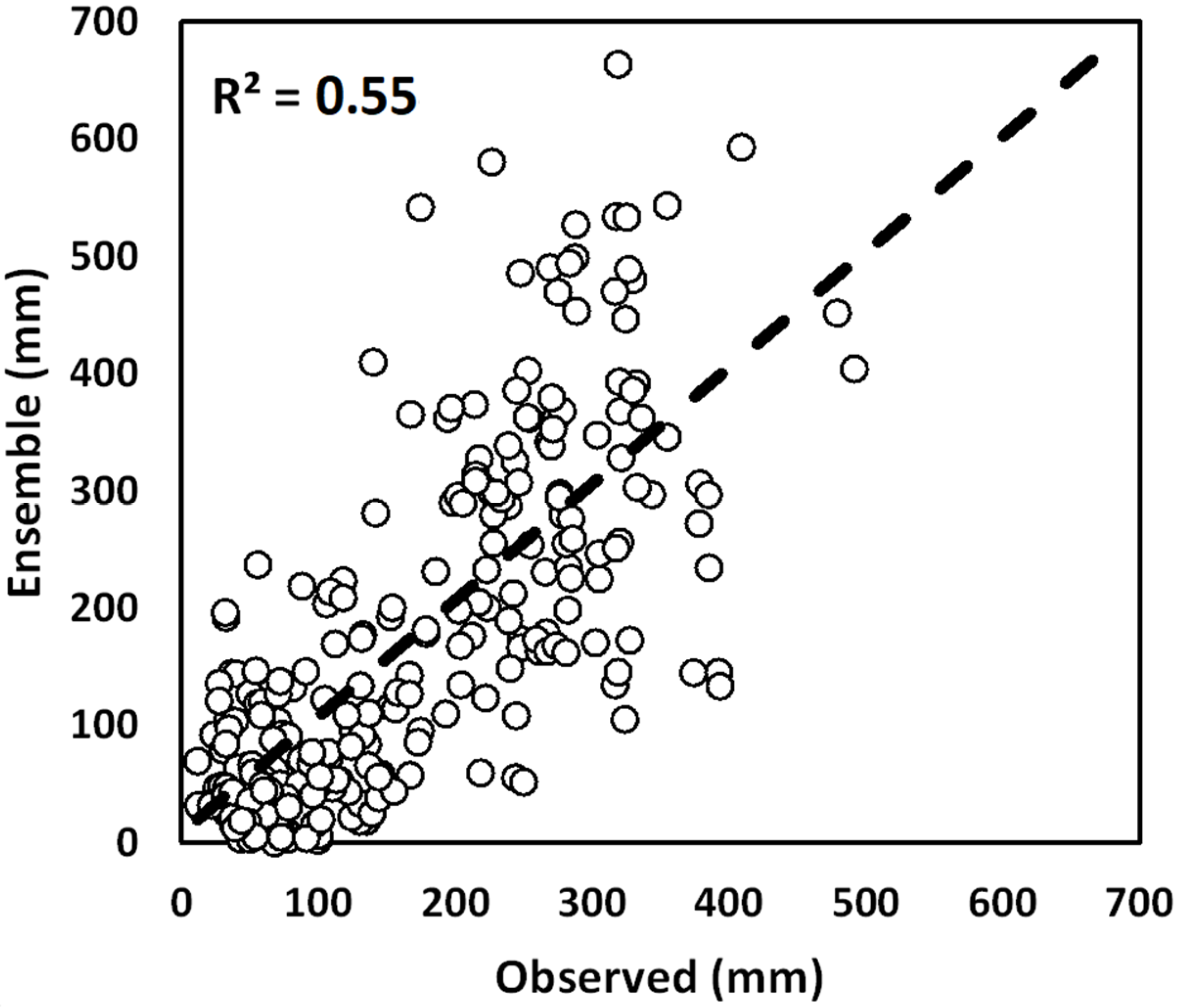
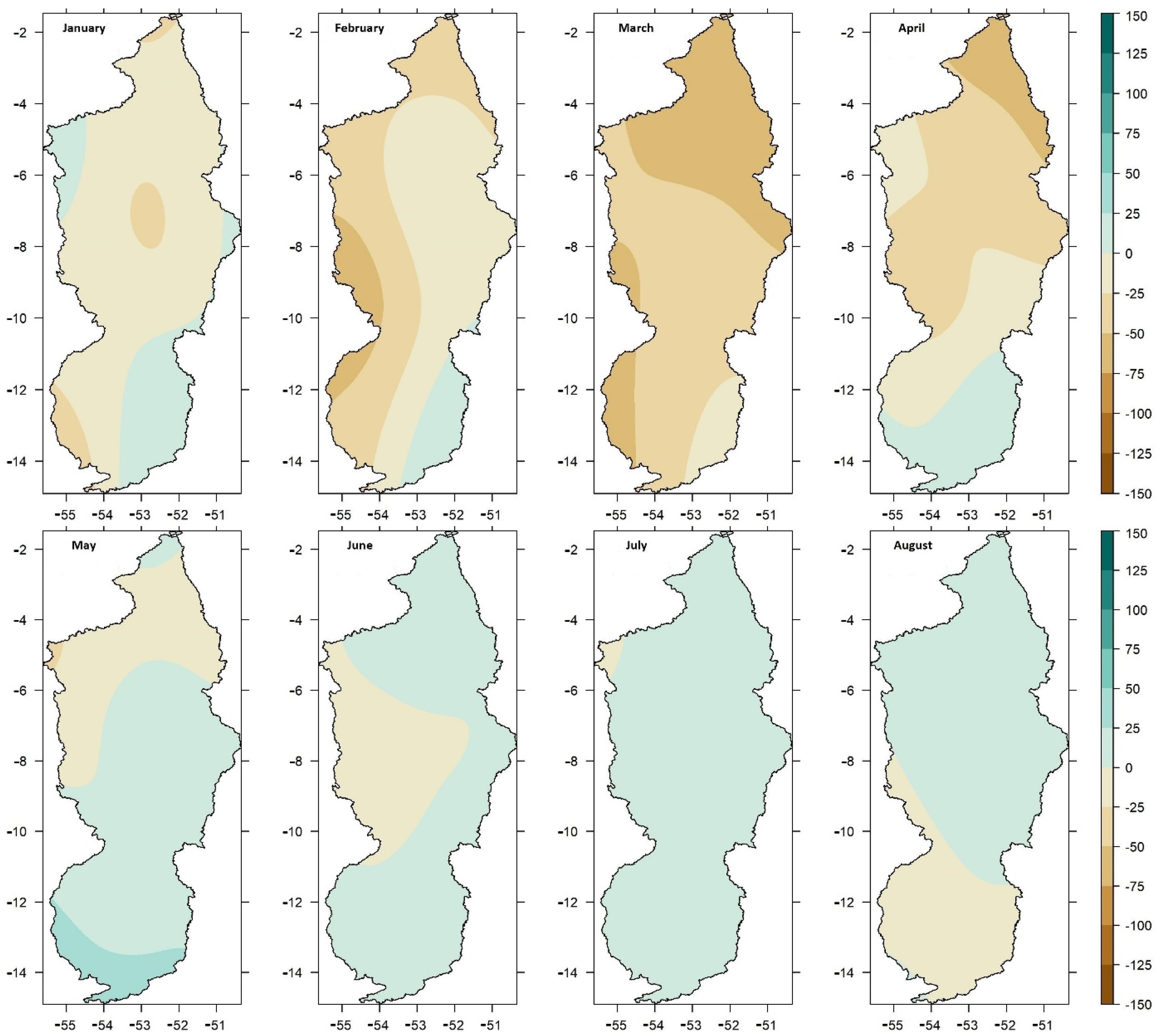
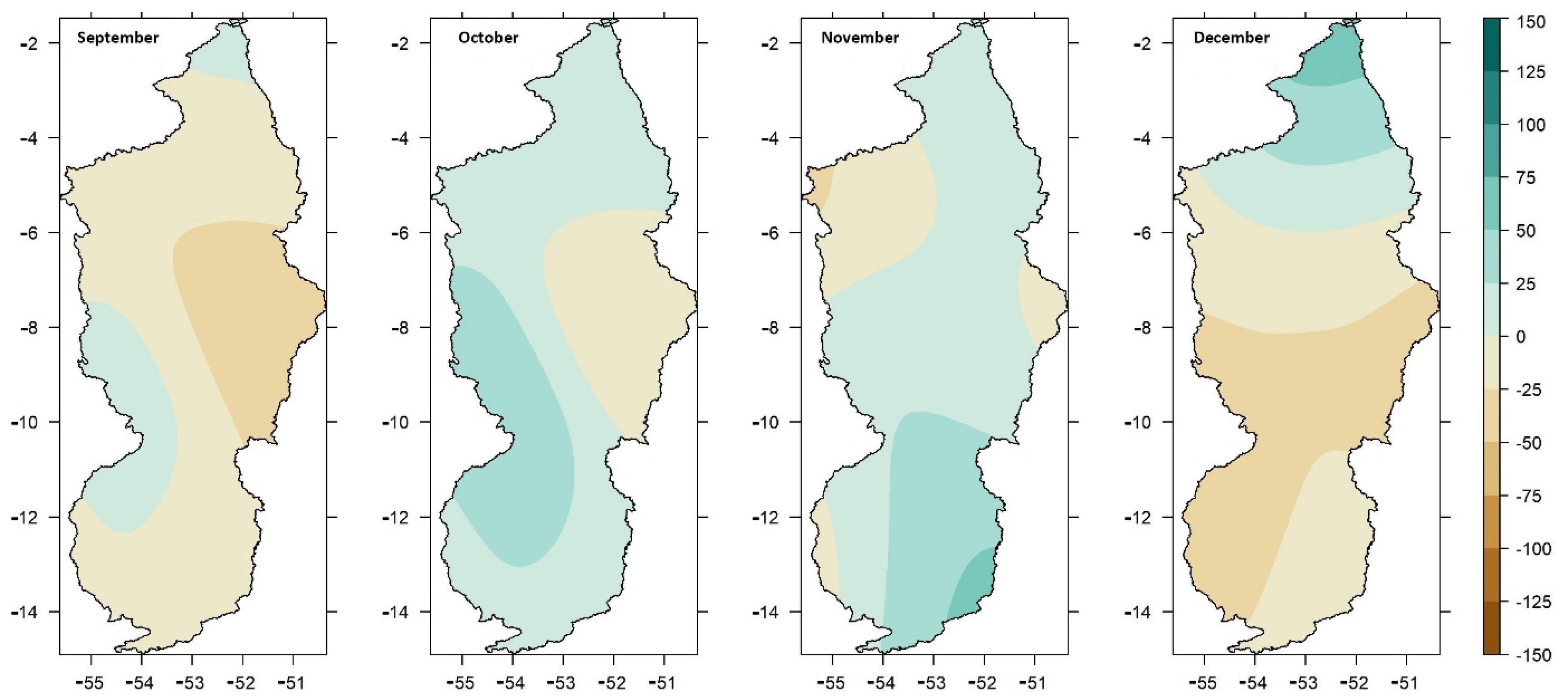
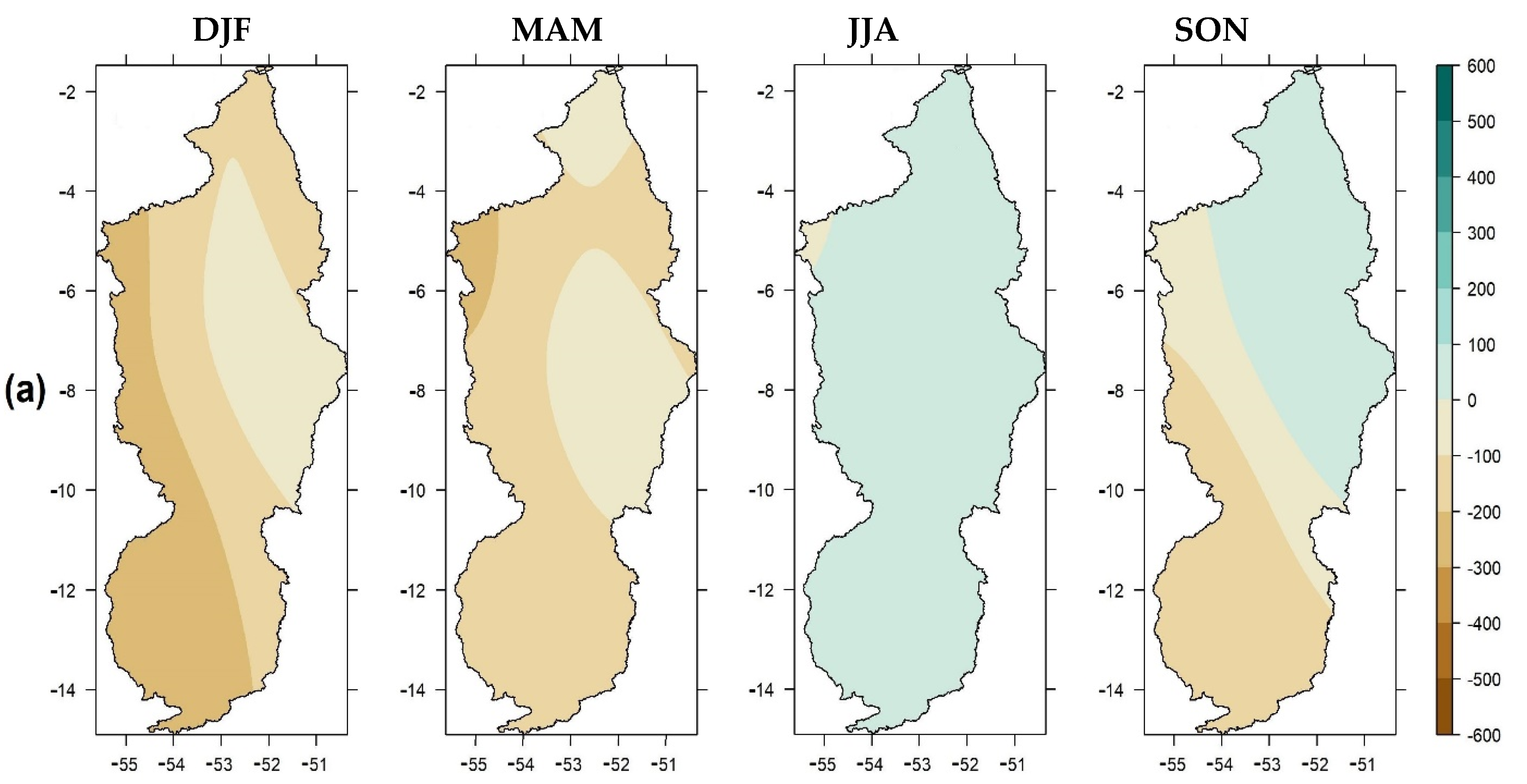

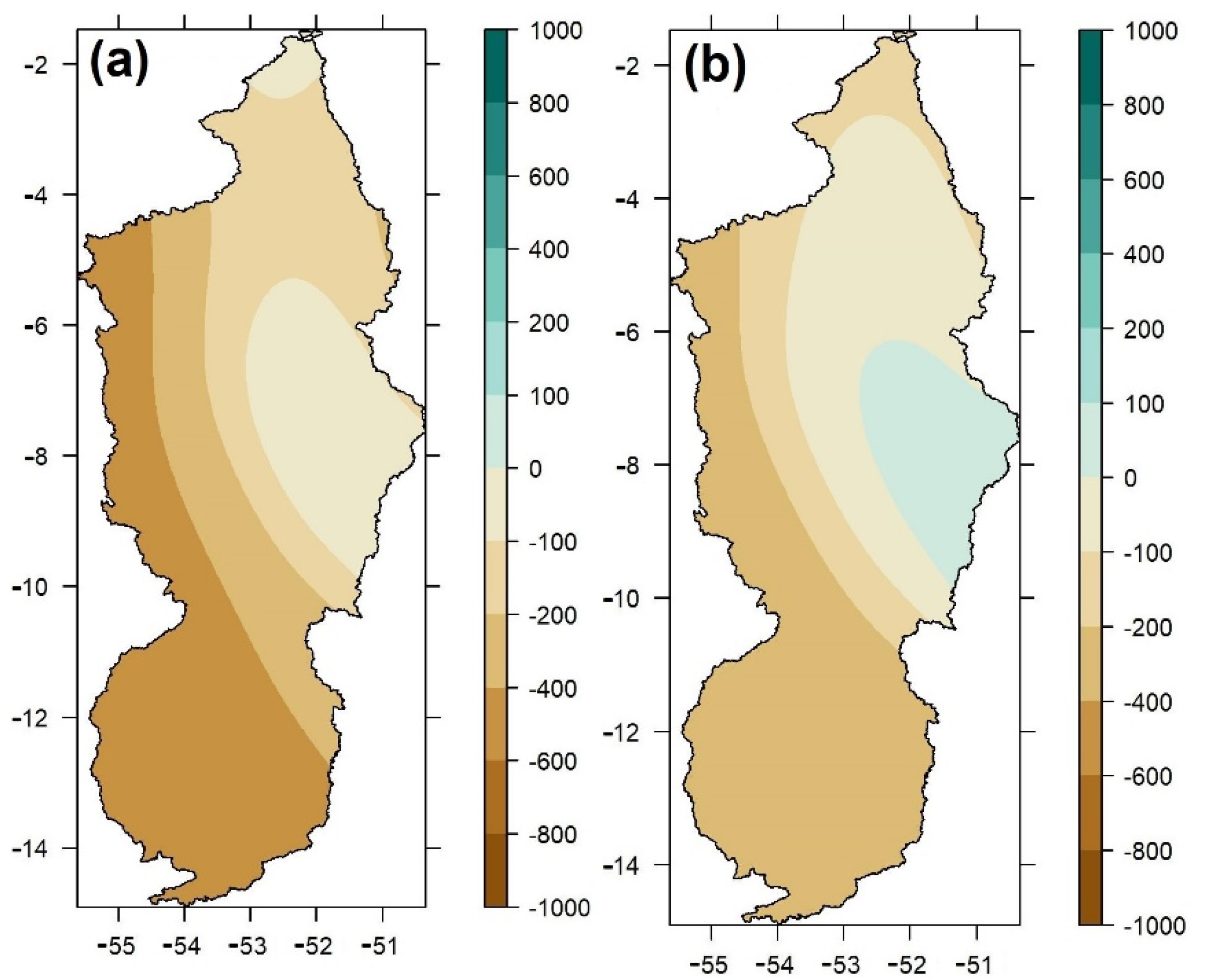
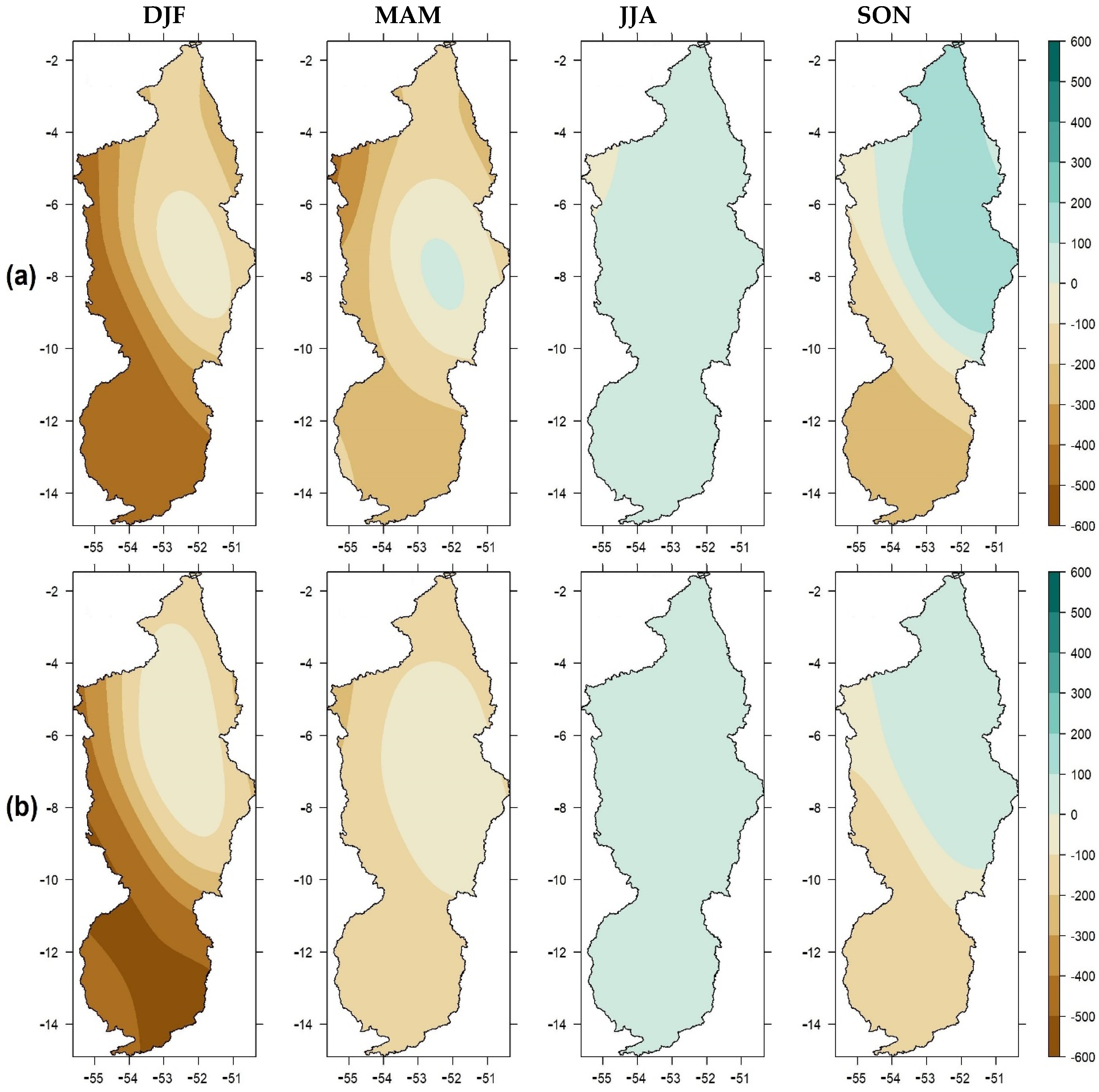
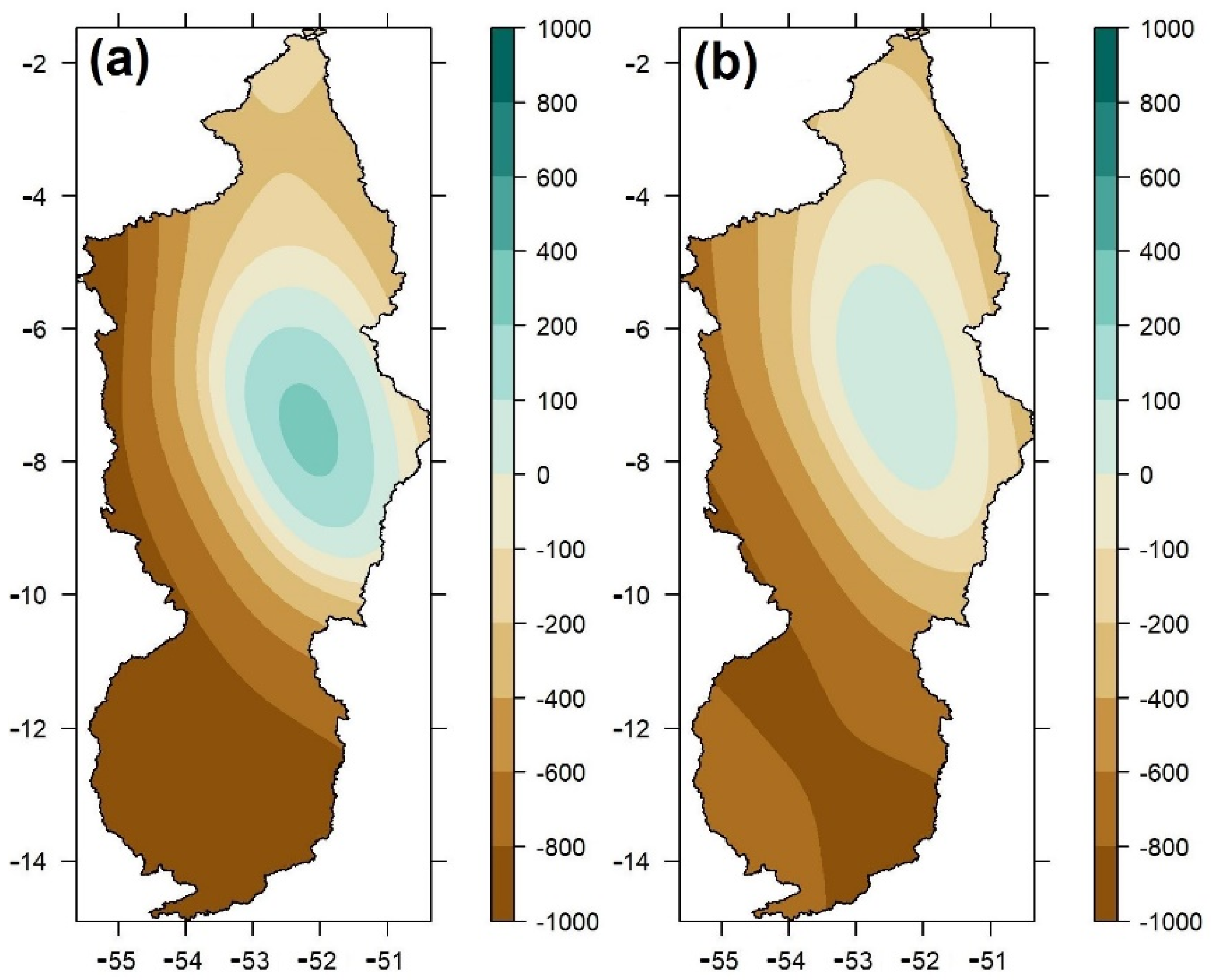
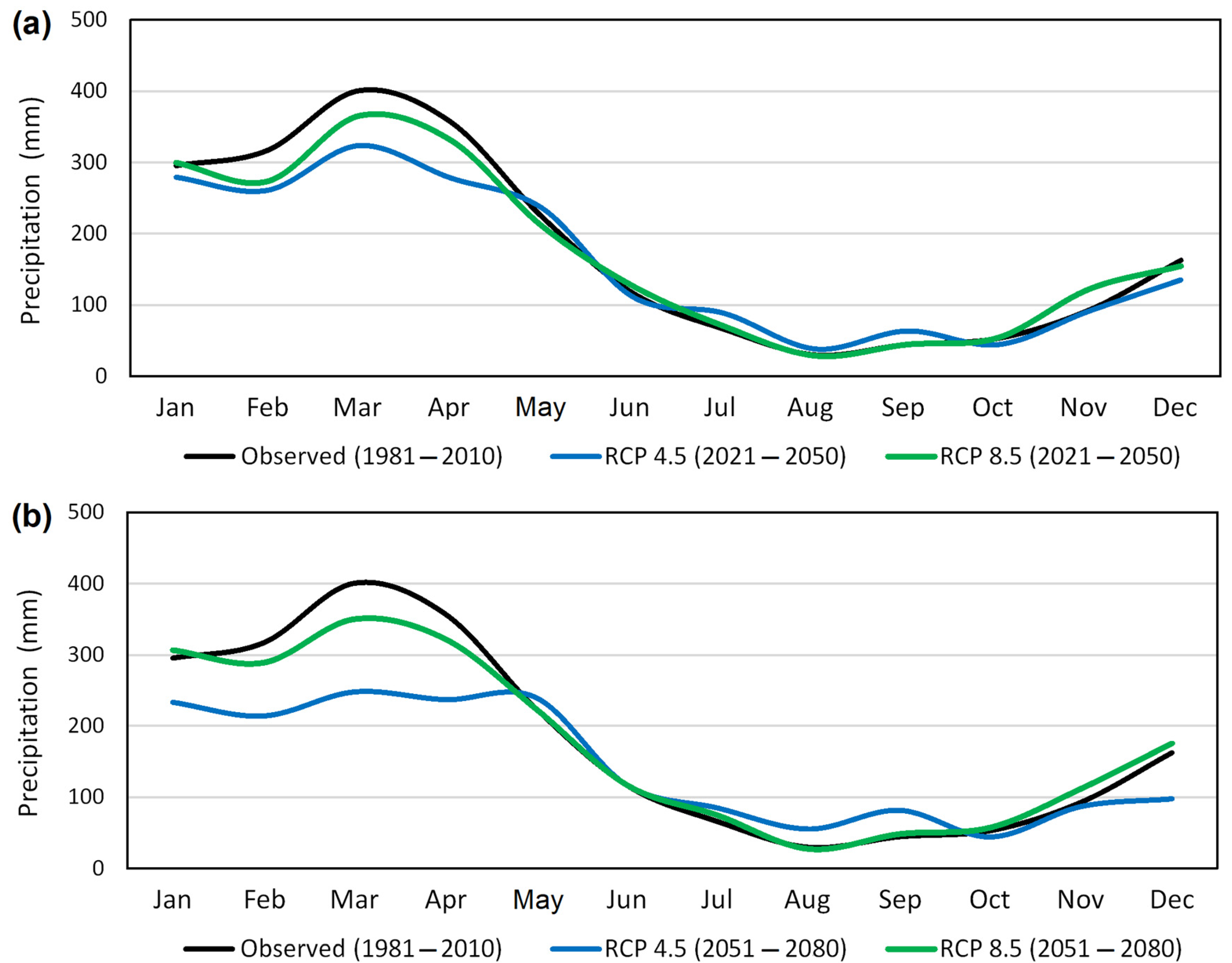


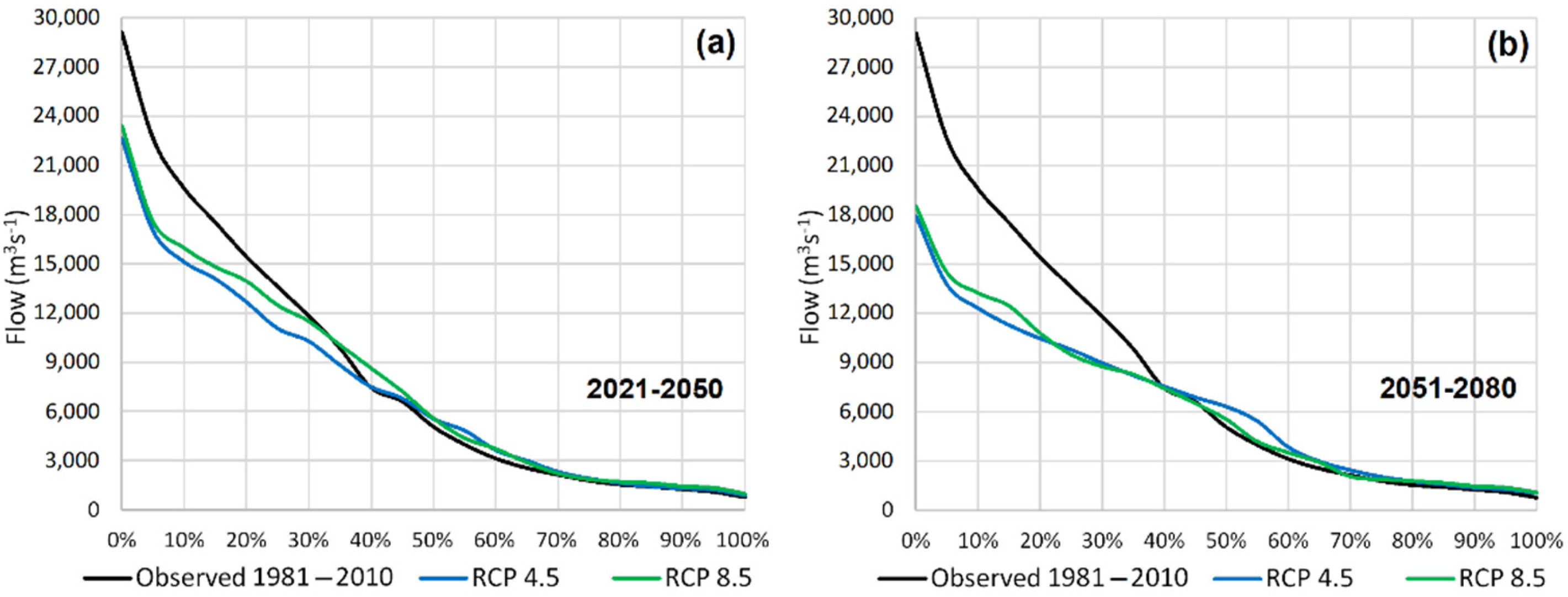
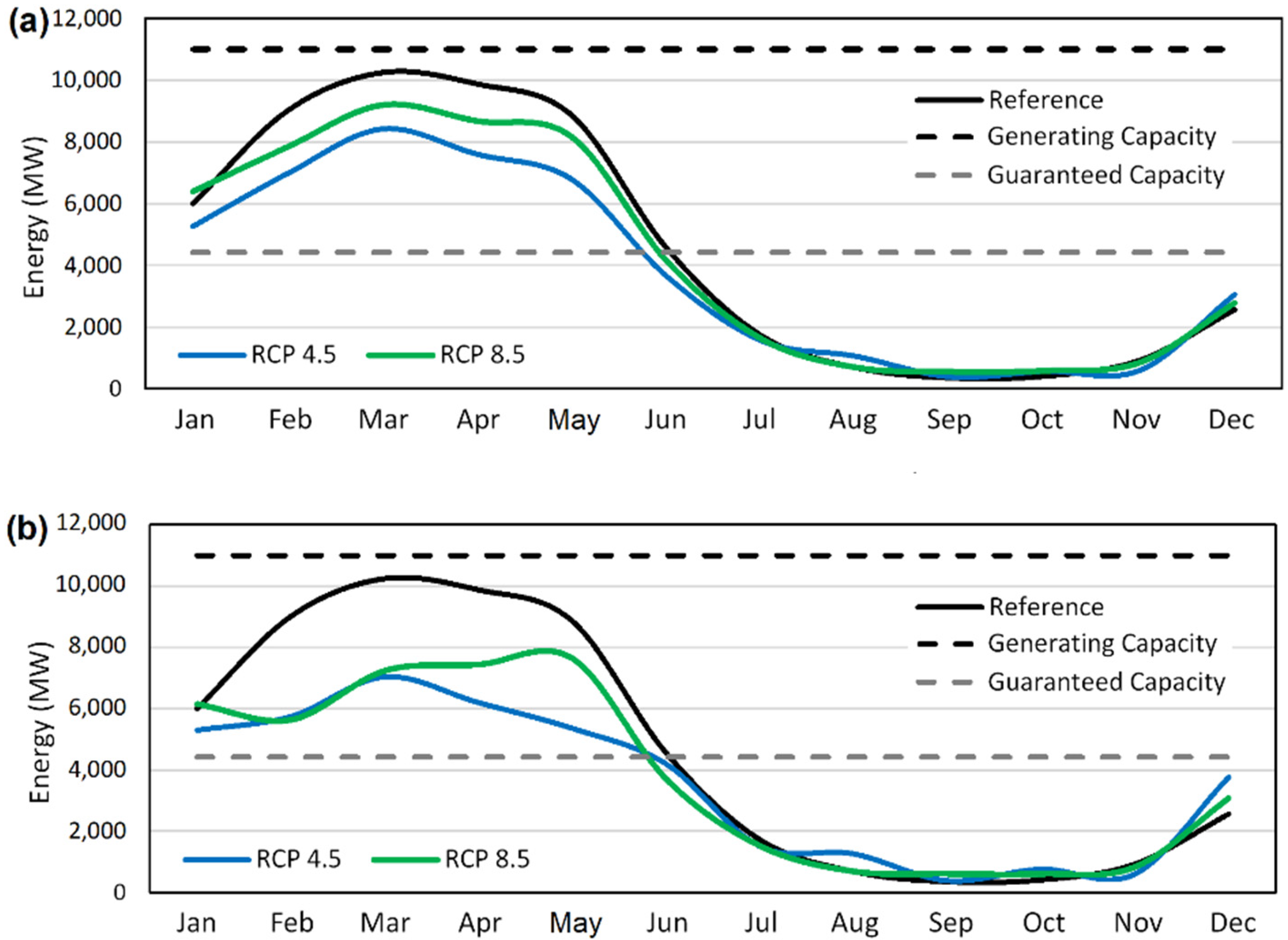
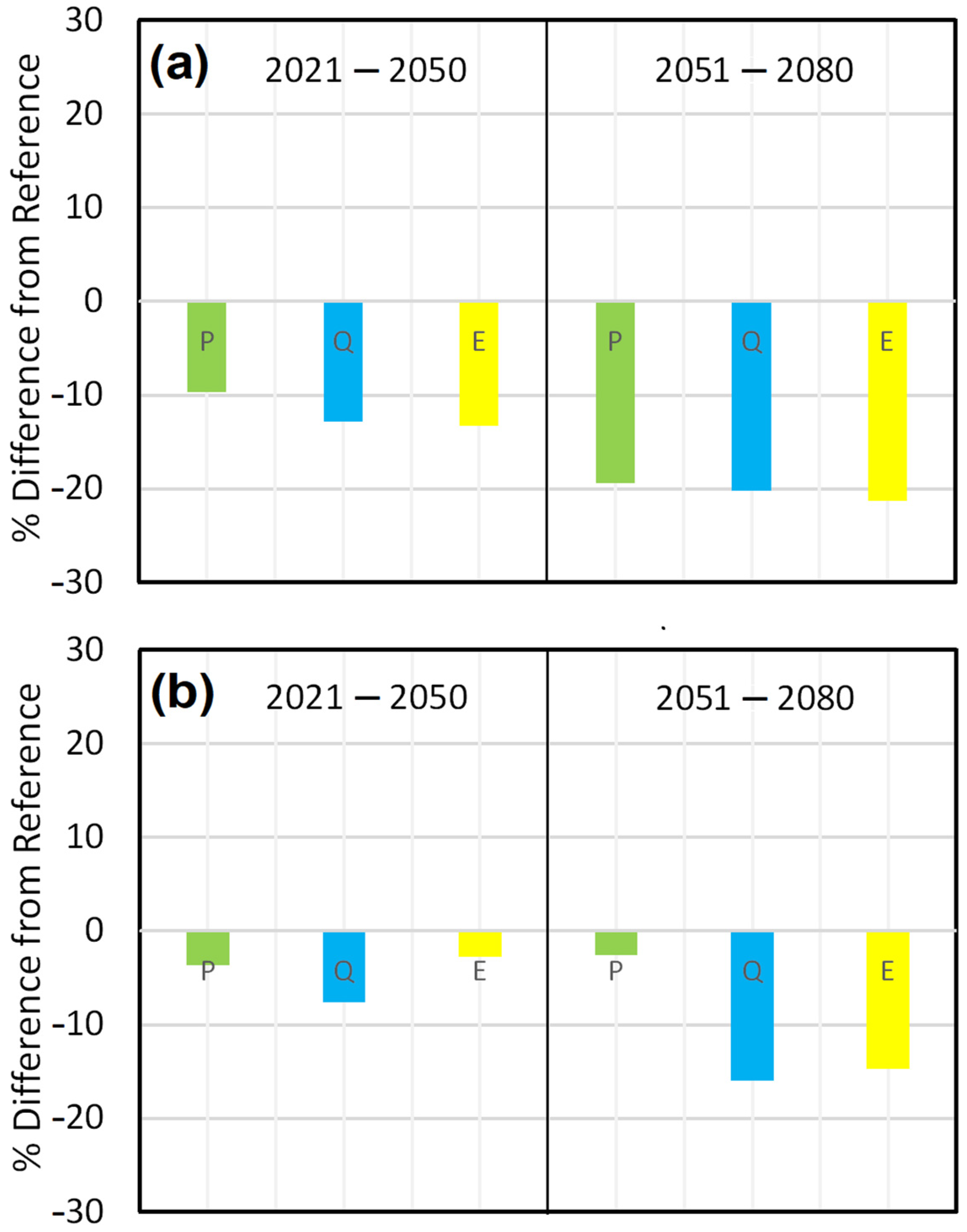
| BMHPP | Flow Rate (m3/s) | Minimum Ecological Flow Rate (m3/s) | |
|---|---|---|---|
| Month | Average | Hydrograph A | Hydrograph B |
| January | 7803 | 1100 | 1100 |
| February | 12,759 | 1600 | 1600 |
| March | 18,178 | 2500 | 4000 |
| April | 20,028 | 4000 | 8000 |
| May | 15,784 | 1800 | 4000 |
| June | 7156 | 1200 | 2000 |
| July | 2902 | 1000 | 1200 |
| August | 1571 | 900 | 900 |
| September | 1069 | 750 | 750 |
| October | 1120 | 700 | 700 |
| November | 1891 | 800 | 800 |
| December | 3754 | 900 | 900 |
| Annual | 7835 | 1438 | 2163 |
| Scenarios | RCP 4.5 | RCP 8.5 | ||
|---|---|---|---|---|
| Period | 2021–2050 | 2051–2080 | 2021–2050 | 2051–2080 |
| DFJ | −12.9 | −29.6 | −6.1 | −0.5 |
| MAM | −14.6 | −26.2 | −7.5 | −8.7 |
| JJA | 12.0 | 21.3 | 6.1 | 3.2 |
| SON | 4.5 | 11.7 | 15.8 | 14.3 |
| ANNUAL | −9.7 | −19.4 | −3.6 | −2.6 |
| Scenarios | RCP 4.5 | RCP 8.5 | ||
|---|---|---|---|---|
| Period | 2021–2050 | 2051–2080 | 2021–2050 | 2051–2080 |
| DFJ | −13.0 | −15.4 | −4.6 | −15.0 |
| MAM | −17.1 | −31.6 | −13.1 | −22.4 |
| JJA | 3.9 | 12.6 | 4.8 | 1.0 |
| SON | −5.8 | −0.3 | 6.9 | 8.6 |
| YEAR | −12.9 | −20.2 | −7.6 | −16.0 |
| Scenarios | RCP 4.5 | RCP 8.5 | ||
|---|---|---|---|---|
| Period | 2021–2050 | 2051–2080 | 2021–2050 | 2051–2080 |
| DJF | 46.4 | 44.9 | 51.6 | 45.1 |
| MAM | 69.1 | 56.4 | 78.9 | 67.7 |
| JJA | 19.0 | 21.2 | 19.6 | 18.0 |
| SON | 4.8 | 5.3 | 6.1 | 6.3 |
| YEAR | 38.8 | 31.6 | 39.1 | 34.3 |
| Scenarios | RCP 4.5 | RCP 8.5 | ||
|---|---|---|---|---|
| Period | 2021–2050 | 2051–2080 | 2021–2050 | 2051–2080 |
| DJF | −12.9 | −15.7 | −3.2 | −15.4 |
| MAM | −21.3 | −35.8 | −10.2 | −23.0 |
| JJA | −10.1 | −0.1 | −7.3 | −15.0 |
| SON | −7.9 | 3.3 | 17.8 | 21.3 |
| YEAR | −13.3 | −21.3 | −2.8 | −14.7 |
Publisher’s Note: MDPI stays neutral with regard to jurisdictional claims in published maps and institutional affiliations. |
© 2022 by the authors. Licensee MDPI, Basel, Switzerland. This article is an open access article distributed under the terms and conditions of the Creative Commons Attribution (CC BY) license (https://creativecommons.org/licenses/by/4.0/).
Share and Cite
Lucas, E.W.M.; dos Santos Silva, F.D.; de Souza, F.d.A.S.; Pinto, D.D.C.; Gomes, H.B.; Gomes, H.B.; Lins, M.C.C.; Herdies, D.L. Regionalization of Climate Change Simulations for the Assessment of Impacts on Precipitation, Flow Rate and Electricity Generation in the Xingu River Basin in the Brazilian Amazon. Energies 2022, 15, 7698. https://doi.org/10.3390/en15207698
Lucas EWM, dos Santos Silva FD, de Souza FdAS, Pinto DDC, Gomes HB, Gomes HB, Lins MCC, Herdies DL. Regionalization of Climate Change Simulations for the Assessment of Impacts on Precipitation, Flow Rate and Electricity Generation in the Xingu River Basin in the Brazilian Amazon. Energies. 2022; 15(20):7698. https://doi.org/10.3390/en15207698
Chicago/Turabian StyleLucas, Edmundo Wallace Monteiro, Fabrício Daniel dos Santos Silva, Francisco de Assis Salviano de Souza, David Duarte Cavalcante Pinto, Heliofábio Barros Gomes, Helber Barros Gomes, Mayara Christine Correia Lins, and Dirceu Luís Herdies. 2022. "Regionalization of Climate Change Simulations for the Assessment of Impacts on Precipitation, Flow Rate and Electricity Generation in the Xingu River Basin in the Brazilian Amazon" Energies 15, no. 20: 7698. https://doi.org/10.3390/en15207698
APA StyleLucas, E. W. M., dos Santos Silva, F. D., de Souza, F. d. A. S., Pinto, D. D. C., Gomes, H. B., Gomes, H. B., Lins, M. C. C., & Herdies, D. L. (2022). Regionalization of Climate Change Simulations for the Assessment of Impacts on Precipitation, Flow Rate and Electricity Generation in the Xingu River Basin in the Brazilian Amazon. Energies, 15(20), 7698. https://doi.org/10.3390/en15207698











